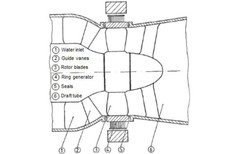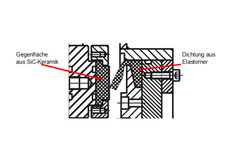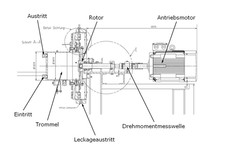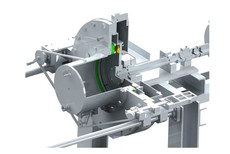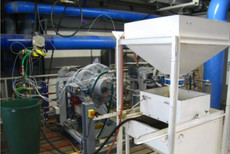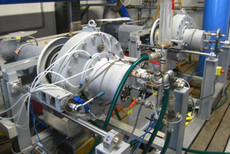Rim-lip-seal of a STRAFLO Kaplan turbine
Since mid-2010, the wear behavior of the outer annulus seal for Straflo Kaplan turbines operated in pure as well as in sediment contaminated water (mainly sand) is being investigated. The Straflo turbine seal consists of an elastomer and a counter face made of SiC ceramics.
The main problem with the outer rim of the Straflo turbine seals is its short lifetime with sandy water. The centrifugal force presses the sand into the region of the seal where it causes heavy wear.
The figure below shows the structure of the test rig for the Straflo Kaplan turbine. It shows that the main pump transports the water into the stationary cylinder with the ceramic counter. As in the realised machine the elastomeric seal is fastened to the rotor which is directly driven by an asynchronous motor. Subsequently, the water leaves the turbine test rig either via the cylinder and the proximate cooling unit or via the seal, and then – in order to measure the amount of leakage water – across a weighing scale. The drive power is measured by means of the already existing torque measurement shaft.
For the investigation of the sealing problem of the Straflo turbine an operating point matrix was defined which consists of 12 combinations of seal preloads and internal pressures covering the whole range of the seal in the actual machine. This matrix was necessary as the double-regulated variant of the Straflo turbine experiences an axial shift from the lowest to the highest performance level of up to 6.5mm.
The model parameters have been selected in such a way that the diameter and sliding surface speeds at the model correspond to those at the actual machine. In order to qualify the influence of the increased centrifugal force, the internal pressure at the test rig necessary for the transfer of the defined matrix of operational points from the actual machine to the model was determined by means of a CFD simulation.
For the initial tests with the Straflo turbine 3 different elastomers were selected providing considerable differences in their wear behaviour and in the drive power needed. Furthermore, it has to be mentioned that – to a great extent – drive power depends on the sense of rotation as well as also on the batch of SiC ceramics applied. Thereupon, test with sandy water were carried out which led to heady wear of the seals within a short period of time – just as it happens with the actual machine. Thus, the actual short-term failure of the seal could be proved on the test rig. The results of the sandy water test led to considerations on how the sand could be kept away from the seal. Therefore, the seal was equipped with a cover, and furthermore, small amount of detergent have been between introduced between seal and cover. As a result, no remarkable increase of drive power or leakage was identified. However, the life-time of the seal could be increased significantly, although still to large amount of sand entered the sealing area. This means, that the seal was not totally protected against intruding sand. Based on these findings the cover element has been further developed.
The development and optimisation of the sealing system for the Straflo turbine provides for an increased axial overlap and for two gaps through which the water flow in axial direction – i.e. a labyrinth seal with one chamber. The test results achieved with this approach were quite promising as only small amount of sand could be found in the seal area at nominal rotational speed. In order to examine the influence of the increased centrifugal force at the model, the rotational speed was reduced stepwise until the centrifugal force was equal to the one at the actual machine. This procedure provided proof for the significant influence of the centrifugal force on the amount of sand intruding the seal area.
Having completed the Straflo turbine sealing tests with different variants of rotational speed – or rather centrifugal speed – it could be demonstrated that intrusion of sand into the seal area can successfully be prevented by installing an appropriate rinsing device.
Test results
The detailed results of the experimental investigations of the seal for a Straflo Kaplan turbine have been published in the paper "Experimental investigation of the rim-lip-seal of a double-regulated Straflo Kaplan turbine under extreme conditions" (published at Hydro 2013, Innsbruck, Austria).
Publications and results
Core competences
References - test rig
Our services for turbines
- Product development
- Designing
- Optimisation
- Refurbishment
- Troubleshooting
» Details




